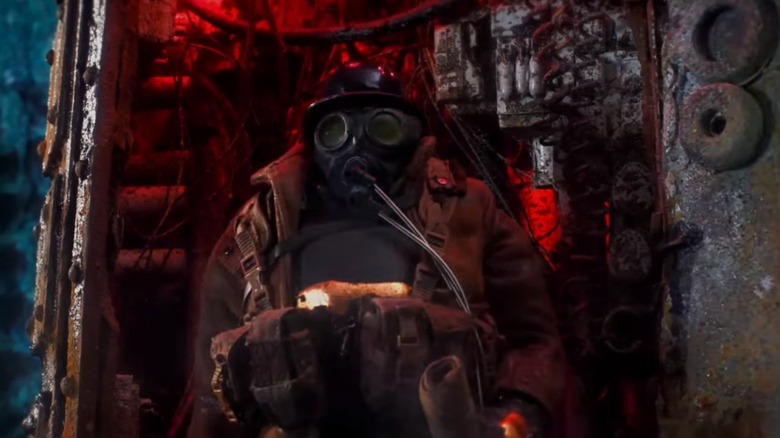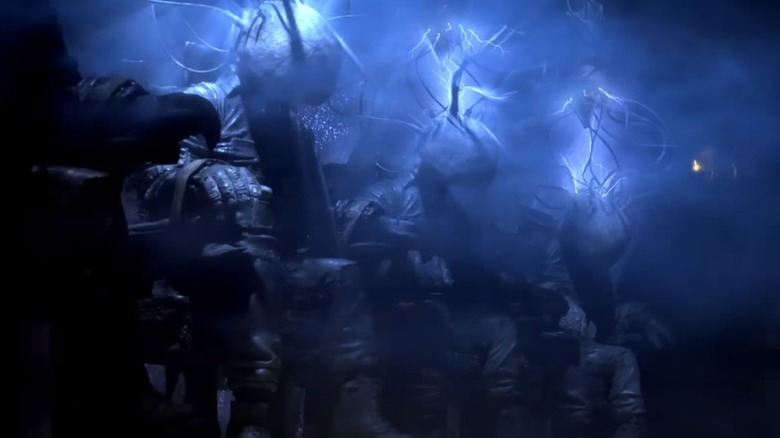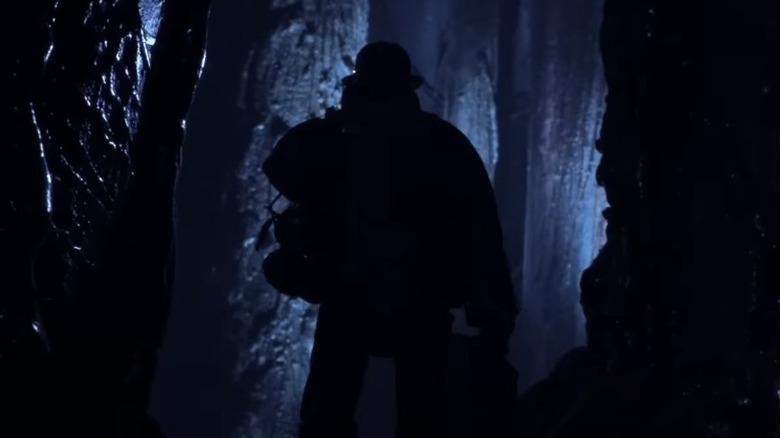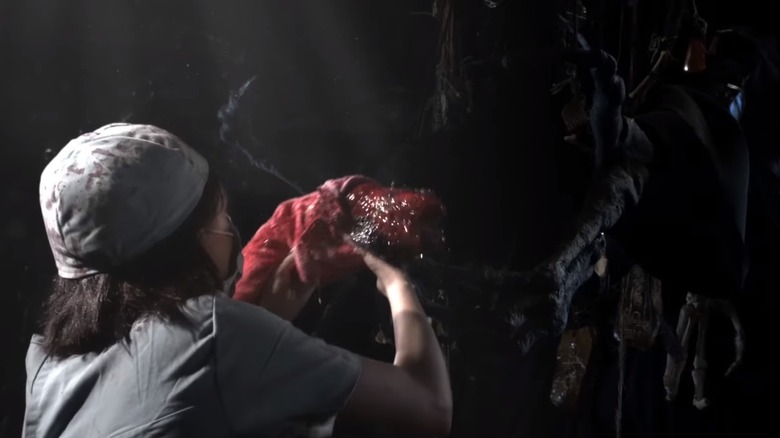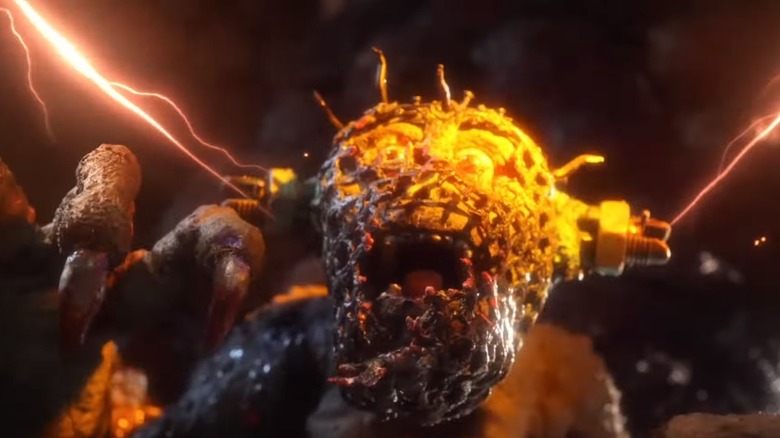Animation Pioneer Phil Tippett On His 30-Year Quest To Bring Mad God To The Screen [Interview]
From co-developing the go motion process that brought the dreaded Imperial Walkers to life in "The Empire Strikes Back" to supervising the creation of the groundbreaking digital dinosaurs in Steven Spielberg's "Jurassic Park," Phil Tippett, now 70, has spent over four decades on the cutting edge of visual effects and animation. Tippett's resume reads like a list of the greatest pop culture moments of the 20th century. After winning his first Academy Award for his work in "Return of the Jedi," he would go on to work his magic in such films as "RoboCop," "Willow," and "Starship Troopers."
In 1989, Tippett began what he hoped would be his magnum opus: a feature-length stop-motion film titled "Mad God." Drawing inspiration from such disparate sources as the Bible, the works of H.P. Lovecraft, and Dante's "Inferno," "Mad God" was to be Tippet's statement on the sorry state of the human condition. Despite his initial enthusiasm for the dark and deeply disturbing project, the visual effects master decided that stop-motion was a rapidly dying art and shelved the project.
Although Tippett readily adapted to the advent of digital technology, his passion for the hands-on art of stop-motion animation remained. Thirty years later, Tippett, with the help of a wildly successful Kickstarter campaign and a legion of volunteers, has at last unleashed "Mad God" on an unsuspecting populace via the horror streaming service Shudder. I recently sat down with Phil Tippett via Zoom to discuss the genesis and themes of "Mad God," and the toll it took on its creator.
'A collage of the world we live in today'
"Mad God" is a dark, complicated film filled with some very stark imagery. What was your inspiration?
Well, the simple answer is the news. It was kind of like the zeitgeist of an interpretation, kind of like a poetic interpretation or a collage of the world we live in today. So I was just kind of channeling that with all the beauty and the horror.
Did you have a complete idea of what the film would be back when you started in 1989? Did the concept change in big or small ways over the last 30 years?
No. You just have a feeling, and you start. As Pablo Picasso said when asked in an interview, "What are you looking for in your paintings?" He said, "I do not seek, I find." That's what artists do. They have like a vibe of some sort, but it's like tuning in a radio station or they're kind of finding a gravitational center and letting all the molecules come together and turn into something else.
And if you look at the equivalent of interviews of Bach, Beethoven, and Mozart, they would say, when asked, "Where does [your] wonderful music come from?" They would say, "I just transcribe it, and it comes from God." So it's like that. Art should be about nothing and let the observer, just like in life, fill in the meaning. And that was my intention with "Mad God."
'The scope of the project was just too big'
How much of the film was shot in 1989 and which sequences?
There were a handful of shots, maybe a half a dozen. The most iconic one was the boom down into the operating theater. The scope of the project was just too big. And then for the next 20 years, just with no real hope of resurrecting "Mad God," I just continued to study psychology and Freud and Jung and everything I could get my hands on — archeology, paleontology, Milton, Dante, H.P. Lovecraft — just, like, everything. Then, when I was archiving and some of the guys at my studio wanted to reboot the thing, [they] did a shot, and it just kind of took off from there. And then, I started — some volunteers gravitated [to the project], and I ended up having a crew that could allow me to complete it. That was around 2010 or 2012.
At any point did you ever consider scrapping the whole thing as it was and going strictly with a CGI interpretation of the story?
Never. No, it wouldn't have worked that way for me. I couldn't be hands-on. This really needed to be a handcrafted thing. And I have no idea how to animate on a computer, nor do I care to ever.
Yet, if you watch through the closing credits, there is a mention of digital effects. What was the role of digital technology in the film?
[It was] pretty much exclusively in compositing. There's one shot at the very beginning of a boom up of this kind of big prison castle. That was one of the things that I'd shot 20 to 30 years ago. I needed to put some scale to it. So the guys at my studio made some digital characters and put them in.
In the past few years, there's been a real resurgence of practical effects and makeup in film. Filmmakers seem to be realizing that the tactile quality of practical effects have a weight that translates to the screen. Do you anticipate that "Mad God" will spark a similar renaissance in stop-motion animation?
Actually, stop-motion has kind of had a resurgence, mostly for commercials. If you go online and go on Instagram, there's a surprising amount of very good stop-motion going on all over the world. Grassroots isn't the right way to characterize it, but it has a core group and more and more people are gravitating towards it because it's so much easier now with the digital technology.
'It's just kind of like the zeitgeist of the world...'
Why is "Mad God" so relentlessly bleak and cruel? Is there hope in the film that we're missing?
Well, do you live in the United States?
I do.
Well, the shootings in Texas — need I say any more? It's just kind of like the zeitgeist of the world and particularly this country, which has gone psychotic. And so, it's a psychotic film. I think that because of all of the inundation of information, and it being recycled and recycled, looking at it over and over again — the destruction of the Twin Towers is a good example. When that happened, there were a bunch of cameras on it, and you just watched it over and over and over. I think that induces a state of psychosis in the population, and I think that, in addition to other forms of media, has driven huge swaths of the population mad.
There are many scenes of faceless characters engaged and what seems to be an unending, pointless grind that's very reminiscent of the myth of Sisyphus. These poor creatures are destroyed by their own work. Is that a metaphor for the film and effects industry, specifically your experience in it?
No, not at all. It's definitely kind of like a post-industrial thing where, particularly at the beginning of the Industrial Age, people were just chopped up by new machines that they didn't know how to work. I think the mindlessness, a great deal going back to the psychosis, is like if you think the same thing over and over and over again, you're essentially a zombie.
The film's protagonist, referred to only as the Assassin, descends into an underworld on a mission during which he is tortured and presumably killed, and, in a manner speaking, resurrected in an ongoing cycle. Do you, or should we, regard the Assassin as a failed Christ figure?
Absolutely not. I mean, you can interpret it any way you want, but certainly, there are elements of resurrection and rebirth. The opening roll-up at the beginning, I found that very much towards the end. I just didn't have the beginning yet. The end, I didn't have until much later in the project. The opening is from Leviticus. Actually, I chose the Torah because it was like a tiny bit meaner than the Bible. And there's a damning entity in there. The main character, the Assassin, gets raped and operated on and has his guts taken out. That's turned into an annoying creature, a baby, that is reduced to its constituent elements by an alchemist and then used to create a new universe that destroys itself and builds itself. Time is relentlessly unimportant. [There's] a little bit of Einstein in there, too.
We touched on Dante earlier. Is "Mad God" your "Inferno?" Are "Purgatorio" and "Paradiso" yet to come?
Well, Dante tells Virgil, I forget the exact quote, but it's basically, "Those who exist in hell do so because they choose it."
'I'm manic, which is my superpower'
Where do you think "Mad God" fits in the current cinematic landscape? Who's the audience for this film?
I didn't care. Paul Verhoeven has said when asked, "Who do you make your movies for?" He said, "Me. I don't care about anybody else." You can see, as evidenced by his films, most of them are misunderstood at the time that he made them.
I understand that the making of "Mad God" took quite a toll on you.
While I was working on "Mad God," I self-diagnosed myself as unipolar, in that I'm manic, which is my superpower. I don't get depressed unless a bunch of kids get shot, and then that's something to be depressed about. It really drives me, and it burned me out. I burned myself out doing this project. So you can call it a religious transformation. It changed me significantly.
The era of cinema we inhabit today has been shaped by your work. What are your thoughts on being one of the architects of modern pop culture?
I was lucky. I mean in the day, with stop motion, there were so few of us. I was always a gig worker. I never wanted to work for, say, ILM, as an employee. I just worked from film to film to film. I was very confident that the phone would ring. Kind of my graduate program was working on commercials in Hollywood, and that had a really high turnover. So that was a big first part of my education. Then, working with Spielberg and Lucas and Verhoeven, they really became mentors to me. Boy, we just were at the 45th anniversary of "Star Wars" down in Anaheim ... and spoke to a theater that had sold out with 5,000 people, and it was being broadcast to who knows how many gazillions.
So my car has no rear view mirror. I never look back, and I only look forward. But the documentary that Larry Kasdan put together, I became very wistful looking at that because there was just a lot of stuff I'd forgotten about or didn't know about. And it's like four hours plus, and I just binge-watched it, and it was very meaningful.
"Mad God" is currently streaming on Shudder.
